Toll-like receptor 3 associates with c-Src tyrosine kinase on endosomes to initiate antiviral signaling
- PMID: 16858407
- PMCID: PMC1523188
- DOI: 10.1038/sj.emboj.7601222
Toll-like receptor 3 associates with c-Src tyrosine kinase on endosomes to initiate antiviral signaling
Abstract
Double-stranded RNA (dsRNA) is produced during the replication cycle of most viruses and triggers antiviral immune responses through Toll-like receptor 3 (TLR3). However, the molecular mechanisms and subcellular compartments associated with dsRNA-TLR3-mediated signaling are largely unknown. Here we show that c-Src tyrosine kinase is activated by dsRNA in human monocyte-derived dendritic cells, and is recruited to TLR3 in a dsRNA-dependent manner. DsRNA-induced activation of interferon-regulatory factor 3 and signal transducer and activator of transcription 1 was abolished in Src kinase-deficient cells, and restored by adding back c-Src, suggesting a central role of c-Src in antiviral immunity. We also provide evidence that TLR3 is localized in the endoplasmic reticulum of unstimulated cells, moves to dsRNA-containing endosomes in response to dsRNA, and colocalizes with c-Src on endosomes containing dsRNA in the lumen. These results provide novel insight into the molecular mechanisms of TLR3-mediated signaling, which may contribute to the understanding of innate immune responses during viral infections.
Figures
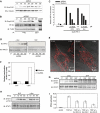
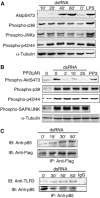



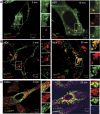
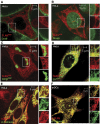
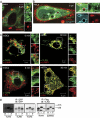
Similar articles
-
Signal regulatory protein alpha negatively regulates both TLR3 and cytoplasmic pathways in type I interferon induction.Mol Immunol. 2008 Jun;45(11):3025-35. doi: 10.1016/j.molimm.2008.03.012. Epub 2008 May 8. Mol Immunol. 2008. PMID: 18471880
-
Double-stranded RNA induces melanocyte death via activation of Toll-like receptor 3.Exp Dermatol. 2011 Feb;20(2):134-9. doi: 10.1111/j.1600-0625.2010.01208.x. Exp Dermatol. 2011. PMID: 21255093
-
Double-stranded RNA signals antiviral and inflammatory programs and dysfunctional glutamate transport in TLR3-expressing astrocytes.Glia. 2005 Nov 1;52(2):153-62. doi: 10.1002/glia.20234. Glia. 2005. PMID: 15920723
-
Functional evolution of the TICAM-1 pathway for extrinsic RNA sensing.Immunol Rev. 2009 Jan;227(1):44-53. doi: 10.1111/j.1600-065X.2008.00723.x. Immunol Rev. 2009. PMID: 19120474 Review.
-
Transcriptional signaling by double-stranded RNA: role of TLR3.Cytokine Growth Factor Rev. 2005 Feb;16(1):1-14. doi: 10.1016/j.cytogfr.2005.01.006. Cytokine Growth Factor Rev. 2005. PMID: 15733829 Review.
Cited by
-
Dasatinib attenuates airway inflammation of asthma exacerbation in mice induced by house dust mites and dsRNA.Biochem Biophys Rep. 2022 Dec 2;33:101402. doi: 10.1016/j.bbrep.2022.101402. eCollection 2023 Mar. Biochem Biophys Rep. 2022. PMID: 36478895 Free PMC article.
-
The role of UNC93B1 protein in surface localization of TLR3 receptor and in cell priming to nucleic acid agonists.J Biol Chem. 2013 Jan 4;288(1):442-54. doi: 10.1074/jbc.M112.413922. Epub 2012 Nov 19. J Biol Chem. 2013. PMID: 23166319 Free PMC article.
-
Src family kinases participate in the regulation of encephalomyocarditis virus-induced cyclooxygenase-2 expression by macrophages.J Gen Virol. 2010 Sep;91(Pt 9):2278-85. doi: 10.1099/vir.0.022665-0. Epub 2010 May 26. J Gen Virol. 2010. PMID: 20505008 Free PMC article.
-
RNA structural domains in noncoding regions of the foot-and-mouth disease virus genome trigger innate immunity in porcine cells and mice.J Virol. 2011 Jul;85(13):6492-501. doi: 10.1128/JVI.00599-11. Epub 2011 Apr 27. J Virol. 2011. PMID: 21525336 Free PMC article.
-
Plant receptors go endosomal: a moving view on signal transduction.Plant Physiol. 2008 Aug;147(4):1565-74. doi: 10.1104/pp.108.120287. Plant Physiol. 2008. PMID: 18678748 Free PMC article. Review. No abstract available.
References
-
- Ahmad-Nejad P, Hacker H, Rutz M, Bauer S, Vabulas RM, Wagner H (2002) Bacterial CPG-DNA and lipopolysaccharides activate Toll-like receptors at distinct cellular compartments. Eur J Immunol 32: 1958–1968 - PubMed
-
- Akira S, Takeda K (2004) Toll-like receptor signalling. Nat Rev Immunol 4: 499–511 - PubMed
-
- Andresen BT, Rizzo MA, Shome K, Romero G (2002) The role of phosphatidic acid in the regulation of the Ras/MEK/Erk signaling cascade. FEBS Lett 531: 65–68 - PubMed
-
- Arbibe L, Mira JP, Teusch N, Kline L, Guha M, Mackman N, Godowski PJ, Ulevitch RJ, Knaus UG (2000) Toll-like receptor 2-mediated NF-kappa B activation requires a Rac1-dependent pathway. Nat Immunol 1: 533–540 - PubMed
-
- Astarie-Dequeker C, Carreno S, Cougoule C, Maridonneau-Parini I (2002) The protein tyrosine kinase Hck is located on lysosomal vesicles that are physically and functionally distinct from CD63-positive lysosomes in human macrophages. J Cell Sci 115: 81–89 - PubMed
Publication types
MeSH terms
Substances
LinkOut - more resources
Full Text Sources
Other Literature Sources
Molecular Biology Databases
Research Materials
Miscellaneous

